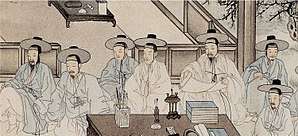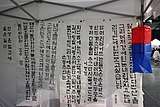Korean calligraphy
 |
| Part of a series on the |
| Culture of Korea |
|---|
| History |
|
Music and performing arts |
|
|
Monuments |
|
National symbols of Korea |
|
| Korean calligraphy | |
| Hangul | 서예 |
|---|---|
| Hanja | 書藝 |
| Revised Romanization | Seoye |
| McCune–Reischauer | Sŏye |
 |
| Calligraphy |
|---|
Korean calligraphy, also known as Seoye (Hangul: 서예; Hanja: 書藝), is the Korean tradition of artistic writing. While early Korean calligraphy was written in Chinese characters, including Hanja, modern Korean calligraphy may be written using Hangul, the native Korean alphabet.[1]
History
Chinese calligraphy was introduced to Korea as early as the 2nd or 3rd century CE, and became popular in the 7th century. In the 8th century, Kim Saeng became known as the earliest Korean calligraphic master, producing work that was compared with that of master Chinese calligrapher Wang Xizhi.[2] In the 9th century, poet Choe Chiwon became known for his calligraphy both in his home country Silla and in the Tang Dynasty.[3]
The angular calligraphy styles of the early Tang masters, Yu Shinan, Ouyang Xun, and Yan Zhenqing, persisted in popularity until the 14th century, when the more rounded style of Zhao Mengfu came into vogue.[4] Korean calligraphy became increasingly formalistic in the years that followed.[5] Kim Jung-hee revolutionized Korean calligraphy in the early 19th century, introducing what is known as the chusa style after his pen name 秋史, inspired by the ancient Chinese lishu script.
As the scholarly classes used Chinese characters, Korean calligraphy used hanja until the 1910–1945 Japanese occupation of Korea. Nationalist sentiment led to the popularization of the native hangul alphabet, and calligraphic works using hangul have since seen a revival, although hanja calligraphy is still popular today.
The Korean calligraphy is developing its own style, steadfastly. Fonts that are not square are being developed, considering jong-sung, or sound coming after the vowel.
Types
There are five major types of Korean calligraphy, which are derived from Chinese calligraphy.[1] They are:
- Jeonseo (전서/篆書), meaning seal script
- Choseo (초서/草書), meaning cursive script
- Haeseo (해서/楷書), meaning block script
- Haengseo (행서/行書), meaning semi-cursive script
- Yeseo (예서/隸書), meaning official script
Gallery

.jpg)


References
- 1 2 Brown, Ju; Brown, John (2006). China, Japan, Korea: Culture and Customs. Ju Brown. pp. 102–104. ISBN 978-1419648939.
- ↑ Chen, Tingyou (2011). Chinese Calligraphy. Cambridge University Press. p. 116. ISBN 978-0521186452.
- ↑ Choi, Yearn-hong (2016-07-08). "Choe Chi-won, great Tang and Silla poet". The Korea Times. Retrieved 2017-12-10.
- ↑ "Korean calligraphy", Encyclopædia Britannica, retrieved 2012-08-23
- ↑ Yi, Ki-baek (1984), A New History of Korea, Harvard University Press, ISBN 9780674615762
External links